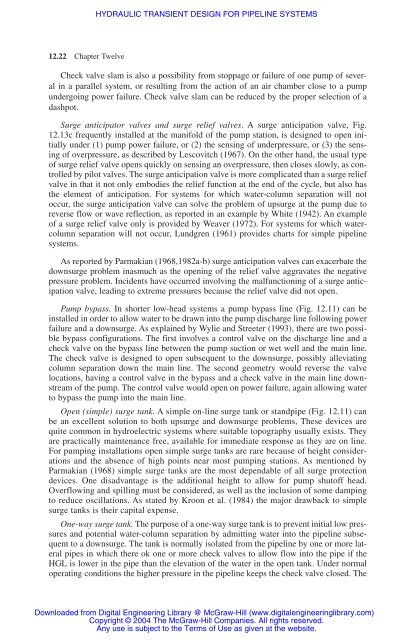chapter 12 hydraulic transient design for pipeline systems
chapter 12 hydraulic transient design for pipeline systems
chapter 12 hydraulic transient design for pipeline systems
Create successful ePaper yourself
Turn your PDF publications into a flip-book with our unique Google optimized e-Paper software.
<strong>12</strong>.22 Chapter Twelve<br />
HYDRAULIC TRANSIENT DESIGN FOR PIPELINE SYSTEMS<br />
Check valve slam is also a possibility from stoppage or failure of one pump of several<br />
in a parallel system, or resulting from the action of an air chamber close to a pump<br />
undergoing power failure. Check valve slam can be reduced by the proper selection of a<br />
dashpot.<br />
Surge anticipator valves and surge relief valves. A surge anticipation valve, Fig.<br />
<strong>12</strong>.13c frequently installed at the manifold of the pump station, is <strong>design</strong>ed to open initially<br />
under (1) pump power failure, or (2) the sensing of underpressure, or (3) the sensing<br />
of overpressure, as described by Lescovitch (1967). On the other hand, the usual type<br />
of surge relief valve opens quickly on sensing an overpressure, then closes slowly, as controlled<br />
by pilot valves. The surge anticipation valve is more complicated than a surge relief<br />
valve in that it not only embodies the relief function at the end of the cycle, but also has<br />
the element of anticipation. For <strong>systems</strong> <strong>for</strong> which water-column separation will not<br />
occur, the surge anticipation valve can solve the problem of upsurge at the pump due to<br />
reverse flow or wave reflection, as reported in an example by White (1942). An example<br />
of a surge relief valve only is provided by Weaver (1972). For <strong>systems</strong> <strong>for</strong> which watercolumn<br />
separation will not occur, Lundgren (1961) provides charts <strong>for</strong> simple <strong>pipeline</strong><br />
<strong>systems</strong>.<br />
As reported by Parmakian (1968,1982a-b) surge anticipation valves can exacerbate the<br />
downsurge problem inasmuch as the opening of the relief valve aggravates the negative<br />
pressure problem. Incidents have occurred involving the malfunctioning of a surge anticipation<br />
valve, leading to extreme pressures because the relief valve did not open.<br />
Pump bypass. In shorter low-head <strong>systems</strong> a pump bypass line (Fig. <strong>12</strong>.11) can be<br />
installed in order to allow water to be drawn into the pump discharge line following power<br />
failure and a downsurge. As explained by Wylie and Streeter (1993), there are two possible<br />
bypass configurations. The first involves a control valve on the discharge line and a<br />
check valve on the bypass line between the pump suction or wet well and the main line.<br />
The check valve is <strong>design</strong>ed to open subsequent to the downsurge, possibly alleviating<br />
column separation down the main line. The second geometry would reverse the valve<br />
locations, having a control valve in the bypass and a check valve in the main line downstream<br />
of the pump. The control valve would open on power failure, again allowing water<br />
to bypass the pump into the main line.<br />
Open (simple) surge tank. A simple on-line surge tank or standpipe (Fig. <strong>12</strong>.11) can<br />
be an excellent solution to both upsurge and downsurge problems, These devices are<br />
quite common in hydroelectric <strong>systems</strong> where suitable topography usually exists. They<br />
are practically maintenance free, available <strong>for</strong> immediate response as they are on line.<br />
For pumping installations open simple surge tanks are rare because of height considerations<br />
and the absence of high points near most pumping stations. As mentioned by<br />
Parmakian (1968) simple surge tanks are the most dependable of all surge protection<br />
devices. One disadvantage is the additional height to allow <strong>for</strong> pump shutoff head.<br />
Overflowing and spilling must be considered, as well as the inclusion of some damping<br />
to reduce oscillations. As stated by Kroon et al. (1984) the major drawback to simple<br />
surge tanks is their capital expense.<br />
One-way surge tank. The purpose of a one-way surge tank is to prevent initial low pressures<br />
and potential water-column separation by admitting water into the <strong>pipeline</strong> subsequent<br />
to a downsurge. The tank is normally isolated from the <strong>pipeline</strong> by one or more lateral<br />
pipes in which there ok one or more check valves to allow flow into the pipe if the<br />
HGL is lower in the pipe than the elevation of the water in the open tank. Under normal<br />
operating conditions the higher pressure in the <strong>pipeline</strong> keeps the check valve closed. The<br />
Downloaded from Digital Engineering Library @ McGraw-Hill (www.digitalengineeringlibrary.com)<br />
Copyright © 2004 The McGraw-Hill Companies. All rights reserved.<br />
Any use is subject to the Terms of Use as given at the website.
















